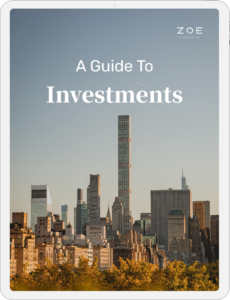Guide to Investments
See The Top Investment Planners Near You
Download our Guide to Investments to learn how to make your money work for you.
Investing correctly can feel intimidating, after all, it’s your hard-earned savings on the line if something goes wrong. Our Guide to Investments takes the guesswork out of investing. By giving you an inside look at investing versus saving, investing in the stock market versus the bond market, and understanding how risk works, you will have insider knowledge on establishing the best basics for successful investing.
Investing helps your money grow. Regardless if you’re investing in picked-stocks, ETFs, bonds, or any other investment vehicle – it’ll grow a little faster than if your money was just sitting in the bank and depending on inflation. Inflation slowly erodes the purchasing power of your dollar, making everything more expensive with every passing year.
Meanwhile, if you’ve saved consistently, there comes a point where your monthly contributions are limited towards reaching your financial goals. By this point, it’s all about how you’ll grow your wealth through compounding. For example, if you’re saving $4,000 a month instead of $400.
While an exciting time to get into investing, there’s also ample risk to consider when investing. A thoughtful, long term, and diversified investing strategy is the best way to make your money work for you.
The trick to investing is to have patience. In the short term the markets will go up and the markets will go down, but in the long run investing usually beats savings hands down. Download our guide to learn how managing your investments thoughtfully can yield higher rewards long term.
The quick answer is risk and reward. Savings are safe but yield a low return. Investments are risky but have a potential higher return. Therefore, the more time you have the better. So the younger you start, the more time you have to allow your money to grow as an investment and benefit from the increased returns over the long term.
An investment portfolio is the mix of stocks, bonds, cash, commodities, and real estate that you own. It’s up to you to decide which assets will compose your portfolio, considering that each will have different risk and potential return. Stocks, for example, are volatile investments that offer potential long term higher returns and losses than cash and bonds. Cash, however, is much less volatile and thus offers much lower expected returns.
Curious about how much your money will grow? Calculate the future value of your investments, your portfolio growth, and increase your ROI with or investment calculator.
Risk capacity is a measure of the magnitude of price declines your investments can take, while still achieving your goals. Top financial advisors are particularly skilled at helping clients identify their risk capacity by stress testing possible future scenarios for both your income and your investments.
Risk tolerance is your willingness to be okay with the worst-case scenarios. In assessing your risk tolerance, imagine how much angst and stress you can manage when the portfolio value is down. If the stress of losses or volatility (price fluctuation) is too much for you to bear, it might be best to adjust your portfolio to reduce the volatility – even if your ability to take more risk is higher than your risk tolerance.
When would you like to retire?
Recent Blogs
Market Drama
Market Drama
Market Drama
Market Drama
Disclosure: This page is not investment advice and should not be relied on for such advice or as a substitute for consultation with professional accounting, tax, legal or financial advisors. The observations of industry trends should not be read as recommendations for stocks or sectors.
Ready to Grow
Your Wealth?
Let us connect you with the most qualified wealth planners
Ready to Grow Your Wealth?
Let us connect you with the most qualified wealth planners
